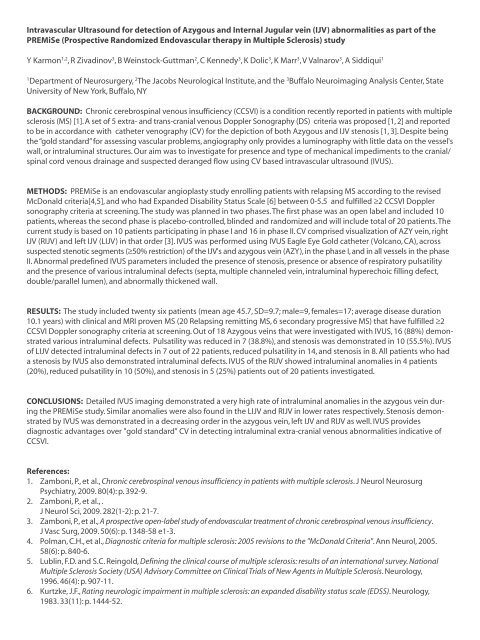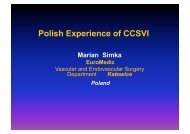ISNVD Abstract Book
ISNVD Abstract Book
ISNVD Abstract Book
You also want an ePaper? Increase the reach of your titles
YUMPU automatically turns print PDFs into web optimized ePapers that Google loves.
Intravascular Ultrasound for detection of Azygous and Internal Jugular vein (IJV) abnormalities as part of the<br />
PREMiSe (Prospective Randomized Endovascular therapy in Multiple Sclerosis) study<br />
Y Karmon 1,2 , R Zivadinov 3 , B Weinstock-Guttman 2 , C Kennedy 3 , K Dolic 3 , K Marr 3 , V Valnarov 3 , A Siddiqui 1<br />
1<br />
Department of Neurosurgery, 2 The Jacobs Neurological Institute, and the 3 Buffalo Neuroimaging Analysis Center, State<br />
University of New York, Buffalo, NY<br />
BACKGROUND: Chronic cerebrospinal venous insufficiency (CCSVI) is a condition recently reported in patients with multiple<br />
sclerosis (MS) [1]. A set of 5 extra- and trans-cranial venous Doppler Sonography (DS) criteria was proposed [1, 2] and reported<br />
to be in accordance with catheter venography (CV) for the depiction of both Azygous and IJV stenosis [1, 3]. Despite being<br />
the “gold standard” for assessing vascular problems, angiography only provides a luminography with little data on the vessel's<br />
wall, or intraluminal structures. Our aim was to investigate for presence and type of mechanical impediments to the cranial/<br />
spinal cord venous drainage and suspected deranged flow using CV based intravascular ultrasound (IVUS).<br />
METHODS: PREMiSe is an endovascular angioplasty study enrolling patients with relapsing MS according to the revised<br />
McDonald criteria[4,5], and who had Expanded Disability Status Scale [6] between 0-5.5 and fulfilled ≥2 CCSVI Doppler<br />
sonography criteria at screening. The study was planned in two phases. The first phase was an open label and included 10<br />
patients, whereas the second phase is placebo-controlled, blinded and randomized and will include total of 20 patients. The<br />
current study is based on 10 patients participating in phase I and 16 in phase II. CV comprised visualization of AZY vein, right<br />
IJV (RIJV) and left IJV (LIJV) in that order [3]. IVUS was performed using IVUS Eagle Eye Gold catheter (Volcano, CA), across<br />
suspected stenotic segments (≥50% restriction) of the IJV's and azygous vein (AZY), in the phase I, and in all vessels in the phase<br />
II. Abnormal predefined IVUS parameters included the presence of stenosis, presence or absence of respiratory pulsatility<br />
and the presence of various intraluminal defects (septa, multiple channeled vein, intraluminal hyperechoic filling defect,<br />
double/parallel lumen), and abnormally thickened wall.<br />
RESULTS: The study included twenty six patients (mean age 45.7, SD=9.7; male=9, females=17; average disease duration<br />
10.1 years) with clinical and MRI proven MS (20 Relapsing remitting MS, 6 secondary progressive MS) that have fulfilled ≥2<br />
CCSVI Doppler sonography criteria at screening. Out of 18 Azygous veins that were investigated with IVUS, 16 (88%) demonstrated<br />
various intraluminal defects. Pulsatility was reduced in 7 (38.8%), and stenosis was demonstrated in 10 (55.5%). IVUS<br />
of LIJV detected intraluminal defects in 7 out of 22 patients, reduced pulsatility in 14, and stenosis in 8. All patients who had<br />
a stenosis by IVUS also demonstrated intraluminal defects. IVUS of the RIJV showed intraluminal anomalies in 4 patients<br />
(20%), reduced pulsatility in 10 (50%), and stenosis in 5 (25%) patients out of 20 patients investigated.<br />
CONCLUSIONS: Detailed IVUS imaging demonstrated a very high rate of intraluminal anomalies in the azygous vein during<br />
the PREMiSe study. Similar anomalies were also found in the LIJV and RIJV in lower rates respectively. Stenosis demonstrated<br />
by IVUS was demonstrated in a decreasing order in the azygous vein, left IJV and RIJV as well. IVUS provides<br />
diagnostic advantages over "gold standard" CV in detecting intraluminal extra-cranial venous abnormalities indicative of<br />
CCSVI.<br />
References:<br />
1. Zamboni, P., et al., Chronic cerebrospinal venous insufficiency in patients with multiple sclerosis. J Neurol Neurosurg<br />
Psychiatry, 2009. 80(4): p. 392-9.<br />
2. Zamboni, P., et al., .<br />
J Neurol Sci, 2009. 282(1-2): p. 21-7.<br />
3. Zamboni, P., et al., A prospective open-label study of endovascular treatment of chronic cerebrospinal venous insufficiency.<br />
J Vasc Surg, 2009. 50(6): p. 1348-58 e1-3.<br />
4. Polman, C.H., et al., Diagnostic criteria for multiple sclerosis: 2005 revisions to the "McDonald Criteria". Ann Neurol, 2005.<br />
58(6): p. 840-6.<br />
5. Lublin, F.D. and S.C. Reingold, Defining the clinical course of multiple sclerosis: results of an international survey. National<br />
Multiple Sclerosis Society (USA) Advisory Committee on Clinical Trials of New Agents in Multiple Sclerosis. Neurology,<br />
1996. 46(4): p. 907-11.<br />
6. Kurtzke, J.F., Rating neurologic impairment in multiple sclerosis: an expanded disability status scale (EDSS). Neurology,<br />
1983. 33(11): p. 1444-52.




